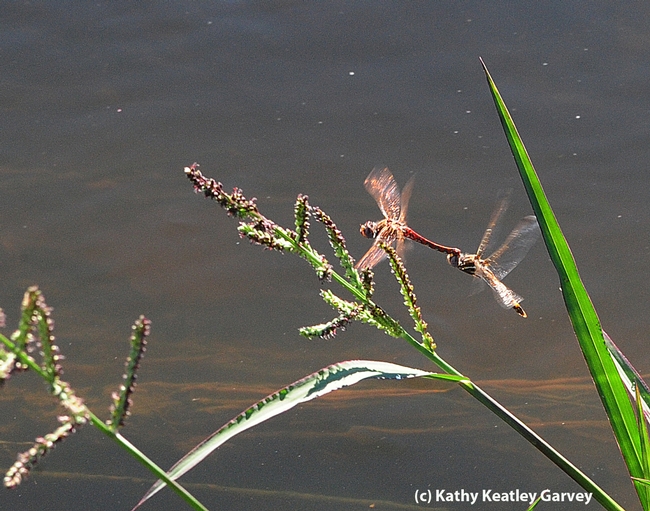If you're around creeks, ponds and irrigation ditches, watch for the dragonflies.
We spotted scores of variegated meadowhawks (Sympetrum corruptum) last Sunday along an irrigation ditch bordering a sunflower field in Winters, Calif.
Like helicopters, they hovered, soared, dropped, sped up and slowed down. Dragonflies can reach speeds up to 30 miles per hour, according to an article, "Chasing Dragons," in the current edition of Audubon.
Written by Jill U. Adams, the article details the art of watching dragonflies, and how this is becoming a passion like birdwatching.
Entomologists call dragonflies "odes," after their order, Odonata. They're also called "dragons."
"Dating back more than 250 million years, odes were around long before the dinosaurs appeared," Adams wrote.
"Odes are easy enough to find at a pond or stream around mid-morning, after the sun has warmed the air. They fly and perch, hunt and mate, from spring until fall."
She quotes dragonfly expert Larry Federman, education coordinator for the three Audubon New York sanctuaries, as saying: "Once you start watching dragonflies, you can't help but notice how amazing they are. They fly at speeds of up to 30 miles per hour, zip forward and backward, pivot in a flash and hover with ease. They prey on live insects in midair, snapping up small bugs with their mouths or grabbing larger ones with their legs, then perching to devour them."
In Winters, we watched their mating rituals. Their bodies hooked together, their double set of wings glittering like precious jewels, they dazzled us with their maneuvers, speed and beauty. So fast, so very fast. (But things are not what they seem; be sure to read National Geographic's piece on the dragonfly mating game.)
What's spectacular about the Audubon feature is a row of 16 dragonfly abdomens lined up like arrowheads or surfboards.
And yes, among the 16 abdomens: the variegated meadowhawk.
It's not as striking as the flame skimmer (that one is firecracker red!), but its coloration is sure to please.
Attached Images:


